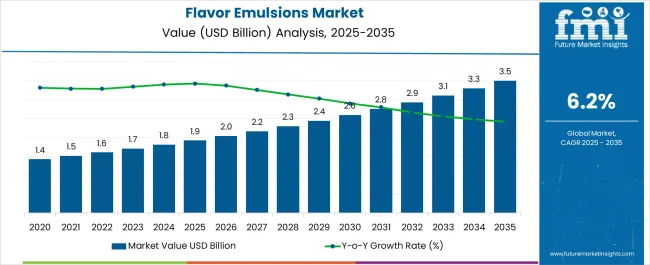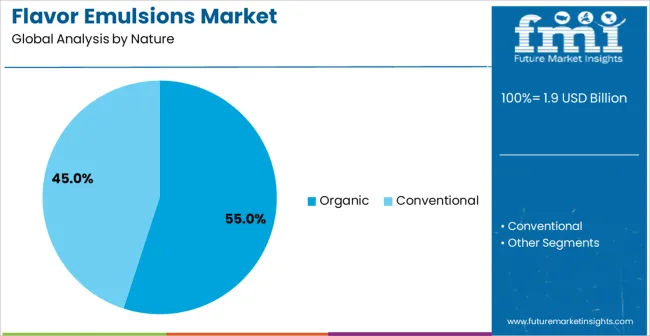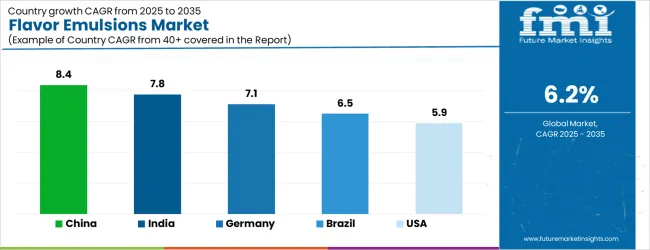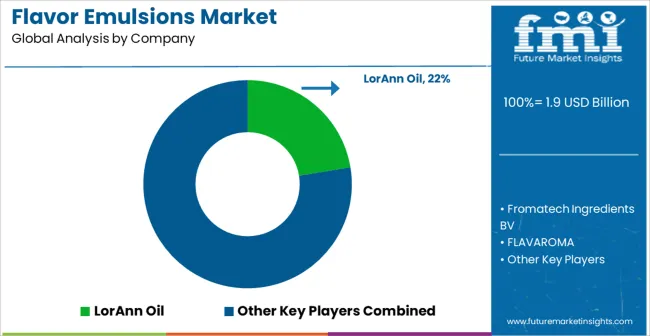The Flavor Emulsions Market is estimated to be valued at USD 1.9 billion in 2025 and is projected to reach USD 3.5 billion by 2035, registering a compound annual growth rate (CAGR) of 6.2% over the forecast period.

| Metric | Value |
|---|---|
| Flavor Emulsions Market Estimated Value in (2025 E) | USD 1.9 billion |
| Flavor Emulsions Market Forecast Value in (2035 F) | USD 3.5 billion |
| Forecast CAGR (2025 to 2035) | 6.2% |
The Flavor Emulsions market is experiencing significant growth driven by the rising demand for natural and safe flavoring solutions in food and beverage products. The future outlook for this market is shaped by the increasing preference for organic and clean-label ingredients among health-conscious consumers. Growing awareness about the adverse effects of synthetic additives has further accelerated the adoption of flavor emulsions in processed and packaged foods.
Additionally, advancements in formulation technologies have enabled manufacturers to create stable and high-quality emulsions that retain flavor during processing and storage, supporting product innovation across the industry. The expansion of the global food and beverage sector, coupled with the increasing diversity of products, has created opportunities for flavor emulsions to be used in a wide variety of applications.
Moreover, regulatory support for natural and organic ingredients has reinforced market growth As consumer preference shifts toward premium, natural, and functional foods, flavor emulsions are anticipated to remain a key component in enhancing taste, aroma, and overall product appeal, ensuring sustained market growth.
The flavor emulsions market is segmented by nature, application, end use, type, flavor, and geographic regions. By nature, flavor emulsions market is divided into Organic and Conventional. In terms of application, flavor emulsions market is classified into Food and Beverage. Based on end use, flavor emulsions market is segmented into Food & Beverage, Convenience Food, Confectionery, Bakery, Functional Beverage, Dairy/Non-Dairy, and Pharmaceutical. By type, flavor emulsions market is segmented into Natural and Artificial. By flavor, flavor emulsions market is segmented into Fruit, Sweet, Chocolate, Savory, and Others (Ginger, Cola, Soda, Etc.). Regionally, the flavor emulsions industry is classified into North America, Latin America, Western Europe, Eastern Europe, Balkan & Baltic Countries, Russia & Belarus, Central Asia, East Asia, South Asia & Pacific, and the Middle East & Africa.

The organic nature segment is projected to hold 55.0% of the Flavor Emulsions market revenue share in 2025, establishing it as the leading segment. This dominance is attributed to the growing consumer preference for natural and sustainable ingredients in food and beverage products.
The segment has benefited from the rising focus on health and wellness, as organic flavor emulsions are perceived to be safer and free from harmful chemicals. Increasing investments by manufacturers in research and development have improved the quality, stability, and versatility of organic emulsions, enabling their use across a wide range of formulations.
Additionally, regulatory incentives and certifications for organic ingredients have further strengthened the adoption of this segment The sustained growth is supported by expanding applications in the food and beverage sector, as well as increasing global awareness of sustainable and environmentally friendly production practices.

The food application segment is expected to account for 20.0% of the Flavor Emulsions market revenue share in 2025, positioning it as a key driver of market growth. This segment has been driven by the continuous innovation in processed and packaged food products, which require consistent and high-quality flavor profiles.
Manufacturers are increasingly incorporating flavor emulsions to enhance taste, aroma, and consumer appeal, while ensuring stability during cooking and storage. The growing consumer demand for diverse and innovative food products has further fueled the use of emulsions in bakery, confectionery, dairy, and savory applications.
Additionally, the expansion of global food production and the rise of convenience foods have accelerated the adoption of emulsions in food applications The segment’s growth is reinforced by the increasing emphasis on natural and clean-label ingredients that improve product quality and meet regulatory standards.

The food and beverage end-use industry segment is anticipated to account for 25.0% of the Flavor Emulsions market revenue in 2025, making it the leading end-use segment. This growth is driven by the escalating demand for enhanced flavor and sensory experiences in food and beverage products. Software-defined emulsions offer scalable and versatile solutions that can be customized to meet the specific requirements of beverages, dairy products, confectionery, and savory items.
The increasing consumer preference for high-quality, natural, and organic flavors has further reinforced adoption in this sector. Additionally, manufacturers are leveraging emulsions to improve product stability, shelf life, and consistency, ensuring a superior consumer experience.
The growth is also supported by the expansion of global food and beverage production, increasing product variety, and rising disposable incomes, which drive the consumption of premium and flavored products These factors collectively establish the food and beverage sector as the dominant end-use industry for flavor emulsions.
As a result of their capacity to improve the palatability of food products, flavor emulsion demand is growing. Due to its capacity to add taste masking ability, the flavor emulsion is also finding use in a variety of sectors. The food and beverage industry is using flavor emulsion because consumers are demanding more ready-to-eat, quick foods with exceptional flavors. Among other things, flavor emulsion is frequently used in bakery goods, sweets, dairy goods, and beverages.
However, the pharmaceutical industry is also increasing its demand for flavor emulsion as a masking agent. To improve the taste of liquid medications and tonics as well as to coat drugs, flavor emulsion is utilized. To give the medications, which are typically administered to infants, a sweet flavor, flavor emulsion is typically utilized. Europe and North America account for a large portion of the production and consumption of flavor emulsion in the world market.
In our new study, ESOMAR-certified market research and consulting firm Future Market Insights (FMI) offers insights into key factors driving demand for Flavor Emulsions.

| Country | CAGR |
|---|---|
| China | 8.4% |
| India | 7.8% |
| Germany | 7.1% |
| Brazil | 6.5% |
| USA | 5.9% |
| UK | 5.3% |
| Japan | 4.7% |
The Flavor Emulsions Market is expected to register a CAGR of 6.2% during the forecast period, exhibiting varied country level momentum. China leads with the highest CAGR of 8.4%, followed by India at 7.8%. Developed markets such as Germany, France, and the UK continue to expand steadily, while the USA is likely to grow at consistent rates. Japan posts the lowest CAGR at 4.7%, yet still underscores a broadly positive trajectory for the global Flavor Emulsions Market. In 2024, Germany held a dominant revenue in the Western Europe market and is expected to grow with a CAGR of 7.1%. The USA Flavor Emulsions Market is estimated to be valued at USD 714.1 million in 2025 and is anticipated to reach a valuation of USD 714.1 million by 2035. Sales are projected to rise at a CAGR of 0.0% over the forecast period between 2025 and 2035. While Japan and South Korea markets are estimated to be valued at USD 94.9 million and USD 51.3 million respectively in 2025.

| Item | Value |
|---|---|
| Quantitative Units | USD 1.9 Billion |
| Nature | Organic and Conventional |
| Application | Food and Beverage |
| End Use | Food & Beverage, Convenience Food, Confectionery, Bakery, Functional Beverage, Dairy/Non-Dairy, and Pharmaceutical |
| Type | Natural and Artificial |
| Flavor | Fruit, Sweet, Chocolate, Savory, and Others (Ginger, Cola, Soda, Etc.) |
| Regions Covered | North America, Europe, Asia-Pacific, Latin America, Middle East & Africa |
| Country Covered | United States, Canada, Germany, France, United Kingdom, China, Japan, India, Brazil, South Africa |
| Key Companies Profiled | LorAnn Oil, Fromatech Ingredients BV, FLAVAROMA, Panteley Toshev Ltd., Gold Coast IngredientsInc., Keva Flavours, Delion Citra Dinamika, Beverage Flavors International, Flavor Producers LLC, Cape Food Ingredients, Flavor on Impex, and Uren Food Ingredients |
The global flavor emulsions market is estimated to be valued at USD 1.9 billion in 2025.
The market size for the flavor emulsions market is projected to reach USD 3.5 billion by 2035.
The flavor emulsions market is expected to grow at a 6.2% CAGR between 2025 and 2035.
The key product types in flavor emulsions market are organic and conventional.
In terms of application, food segment to command 20.0% share in the flavor emulsions market in 2025.






Our Research Products

The "Full Research Suite" delivers actionable market intel, deep dives on markets or technologies, so clients act faster, cut risk, and unlock growth.

The Leaderboard benchmarks and ranks top vendors, classifying them as Established Leaders, Leading Challengers, or Disruptors & Challengers.

Locates where complements amplify value and substitutes erode it, forecasting net impact by horizon

We deliver granular, decision-grade intel: market sizing, 5-year forecasts, pricing, adoption, usage, revenue, and operational KPIs—plus competitor tracking, regulation, and value chains—across 60 countries broadly.

Spot the shifts before they hit your P&L. We track inflection points, adoption curves, pricing moves, and ecosystem plays to show where demand is heading, why it is changing, and what to do next across high-growth markets and disruptive tech

Real-time reads of user behavior. We track shifting priorities, perceptions of today’s and next-gen services, and provider experience, then pace how fast tech moves from trial to adoption, blending buyer, consumer, and channel inputs with social signals (#WhySwitch, #UX).

Partner with our analyst team to build a custom report designed around your business priorities. From analysing market trends to assessing competitors or crafting bespoke datasets, we tailor insights to your needs.
Supplier Intelligence
Discovery & Profiling
Capacity & Footprint
Performance & Risk
Compliance & Governance
Commercial Readiness
Who Supplies Whom
Scorecards & Shortlists
Playbooks & Docs
Category Intelligence
Definition & Scope
Demand & Use Cases
Cost Drivers
Market Structure
Supply Chain Map
Trade & Policy
Operating Norms
Deliverables
Buyer Intelligence
Account Basics
Spend & Scope
Procurement Model
Vendor Requirements
Terms & Policies
Entry Strategy
Pain Points & Triggers
Outputs
Pricing Analysis
Benchmarks
Trends
Should-Cost
Indexation
Landed Cost
Commercial Terms
Deliverables
Brand Analysis
Positioning & Value Prop
Share & Presence
Customer Evidence
Go-to-Market
Digital & Reputation
Compliance & Trust
KPIs & Gaps
Outputs
Full Research Suite comprises of:
Market outlook & trends analysis
Interviews & case studies
Strategic recommendations
Vendor profiles & capabilities analysis
5-year forecasts
8 regions and 60+ country-level data splits
Market segment data splits
12 months of continuous data updates
DELIVERED AS:
PDF EXCEL ONLINE
Flavor Modulator Market Size and Share Forecast Outlook 2025 to 2035
Flavor Modulators Market Size and Share Forecast Outlook 2025 to 2035
Flavor Masking Agents Market Size and Share Forecast Outlook 2025 to 2035
Flavor Compounds Market Size and Share Forecast Outlook 2025 to 2035
Flavoring Cosmetic Formulation Agents Market Size and Share Forecast Outlook 2025 to 2035
Flavored Whiskey Market Size and Share Forecast Outlook 2025 to 2035
Flavored Butter And Oils Market Size and Share Forecast Outlook 2025 to 2035
Flavoring Oils Market Size and Share Forecast Outlook 2025 to 2035
Flavoring Agents Market Size and Share Forecast Outlook 2025 to 2035
Flavors for Pharmaceutical & Healthcare Applications Market Size and Share Forecast Outlook 2025 to 2035
Flavor Capsule Cigarette Market Analysis - Size, Share, and Forecast 2025 to 2035
Flavored Syrup Market Analysis - Size, Share, and Forecast Outlook 2025 to 2035
Analysis and Growth Projections for Flavor and Flavor Enhancers Market
Flavored Yogurt Market Analysis by Form, Flavor, End Use and Distribution Channel Through 2035
Flavors and Fragrances Market Analysis by Type, Nature, Application, and Region through 2035
Flavor Emulsion Market Analysis by Nature, End-Use, Distribution Channel, and Region - Growth, trends and forecast from 2025 to 2035
Flavored Salt Market Insights - Seasoning Trends & Growth 2025 to 2035
Flavored Water Market Trends - Hydration & Wellness Demand 2025 to 2035
Flavored CBD Powder Market Growth - Innovations & Consumer Trends 2025 to 2035
Flavor Drops Market Growth - Beverage & Functional Trends 2025 to 2035

Thank you!
You will receive an email from our Business Development Manager. Please be sure to check your SPAM/JUNK folder too.
Chat With
MaRIA